The Bolland Family
A Family History and ramblings of family life.
By George and Tony Bolland
The Bolland family tree has been traced to John Bollands (c.1638), who lived in the area around Rutland Water.
Our grandad, Joseph William Bolland (born 1882), was born near Edith Weston, now on the shores of Rutland Water, and eventually moved to the Bottesford area (after brief spell in Sussex as a groom), to be employed in agriculture. He met and married Martha Eliza Worrell (born 1880 in Gosport, Hants) and they lived in Retford Cottages (also known as Dyer’s Cottages, as previously mentioned on this site).
They had three children, Joseph (our dad), Henry and David. David at one time was Chief Postmaster at Bottesford. Joseph (grandad) originally an agricultural worker/waggoner was latterly employed by the council as a road repairer/sweeper.
Joseph Bolland (dad)
Joseph (dad, born 1910) worked for Phillips the bakers as a general help and delivery driver then as an agricultural worker for various farms and finishing on Daybells farm before moving to work for W.J. Roberts.
During the second world war, being in a reserved occupation, dad joined the local home guard. He was also involved in the organising and participating in most sporting activities football, cricket, skittles and darts, etc.
Being also a member of the church choir and bell-ringing group, he worked at the Rectory for Canon Blackmore as a gardener for the benefit of a growing family. When dad died (1965), he was so well thought of in the village that the church was packed for his service.
Our family
Joseph married Rhoda Mary Wand (born Foston 1912) and they had six children: Jeff, George, Jean, Ray, Ken and Tony. They all lived for a time in Retford Cottages, and because these were only two bedroom houses (inevitably becoming a bit cramped) they knocked through into the adjacent cottage to make them into one larger cottage, though the four older boys were sharing one room.
In the early 1950s the family moved to the new council estate in North Crescent, off Belvoir Road – furniture being moved on a horse and dray with Ray and Ken on top. Along with the church choir and bell-ringing, the family took part in many other village activities such as Brownies, Guides, Cubs, Scouts, skittles, darts, cricket and football. At some point all the boys played football for school or village.
Family Ramblings (Reminiscences of village life)
To quote from a poem by Thomas Hood
I remember, I remember,
The house where I was born,
The little window where the sun
Came peeping in at morn’…………..
We really can remember this as part of a growing family in Retford Cottages (Dyer’s Yard).
To reach our house, you passed through an “archway” off Chapel Street (which is still there) into the backyard of a row of cottages. The “archway” is now sealed and the cottages demolished.
The toilets were across the yard (ours had drains which went into a cess pit). There was a solid fuel brick copper in the scullery for hand-washing clothes using a dolly tub and poncher “dolly peg” (washing machine), then a ringer or “mangle” (spin drier). Water was from a communal pump and carried in by hand. There was an outside clothes line “airing and drying”. Our fridge was a cupboard with cold slab.
Beside the scullery the only other room downstairs was used for :-
Cooking, bathing (in a galvanised bath, stored outside hung on the wall), eating around the table, and for recreation (cards, ludo, snakes and ladders etc). The radio, whose accumulator would be recharged at Christmas and Chorlton’s Garage on the High Street, was used for listening to Dick Barton (Special Agent), Valentine Dyall (The Man In Black), etc.
The main bedroom for mum and dad was also the maternity ward where we were all born in the prescence of a midwife (plus plenty of hot water). The doctor was called only in emergencies.
The second bedroom was a small room with a sloping roof, the top of the window being 18″ from the floor. The room was dark with just a double bed, without room for a wardrobe or drawers and also minus a door to the stairs. Jeff and George shared this room.
As the family grew, our landlady Mrs Dyer employed a local builder, Mr.J.Norris & Sons, to knock two houses together and turn a dormer window into a small bedroom. This room was eventully used by Jean, with Jeff and George sharing the “new” large bedroom. The fourth bedroom (with its sloping ceiling and small window) became a storeroom.
The family now had two extra rooms downstairs (whow!!!). Now there was a sitting room/lounge, a separate recreation room, another fire and another table. We had a new mains radio (with magic eye for tuning) and room for a darts board. The additional scullery was used as a store room.
Electricity was brought into the village and eventually into the house; later there was mains water but only as a tap over a new sink in the scullery.
Ray and Ken arrived into the world and eventually joined Jeff and George in another double bed in the same bedroom (how cosy!!).
We still discuss, disagree, have different opinions and different outlooks on life, but still love each other. We all see each other over the year and annually we meet up for a weekend away in a hotel/pub somewhere to put the world to rights (good excuse for a few drinks!!). Generally we still enjoy each others company, comparing notes and looking back with nostalgia at a lovely childhood in Bottesford……………(Sounds like the Waltons).
Tony was the last to arrive into the family and he gave us a scare at birth. While the midwife was calling the doctor, there was panic for a while with Jeff and George finding bricks in the garden to raise the foot of the bed due mum having birthing problems (haemorrhage). Success! Tony arrived (I must say that I knew nothing about this so it is not my fault!!! – Being the youngest I always got the blame) and mum recovered to carry on lovingly caring for the family.
Dad, instead of having a holiday from work (we never as a family could afford a holiday), chose to have a piglet from the farm in exchange. This he kept in the rectory stables (opposite the “Six Bells”) for free, a privilege because he worked in the Rectory grounds. Swill collected from friends plus meal from the local watermill (the name Jock Bains the miller rings a bell) fattened the pig.
The local butcher at this time was Johnny George (Eric’s dad) —- our George was the butcher’s boy who delivered meat on a butcher’s bike with a basket on the front.
Johnny George held a licence to slaughter, humanely, animals for the butchery trade, so he was contracted to kill our pig in Miller’s farmyard on Chapel Street. As witnessed by brothers Jeff and George, the process went as follows (not for the squeamish) :-
The pig was straddled across a scratch (a low strong table with handles on each corner), held still in this position the butcher held an unusual bell shaped “GUN” to the pigs forehead then struck the handle end with a hammer. This caused an explosion, killing the pig instantly (a sharp object fired into the brain) but not without the violent nervous kicking reactions.
Next the neck was cut to drain the blood from the body – the meat will then be lighter in colour, better to cure and more edible. The hair was then scraped off using boiling water and scrapers.
The next process was to gut the pig, the edible offals saved, guts thrown away. Carving next, feet off (pigs trotters), hams off, two sides, the head taken off to make brawn.
Some of the meat was cut to make Pork Pies. An old lady, who lived in the same row of houses and had knowledge of preparing these, did the preparation. She was Granny Guy, mother of Sylvia Guy’s (now Sylvia Adlington). The pies were then baked in Phillips the baker’s oven at reduced rate as the ovens were cooling after a days bread baking. The rest of the meat was carved, salted and laid in a salting tray.
The hams and large pieces were hung from the ceiling in the second scullery/storeroom. A joint was cut as and when necessary. A keen eye was required throughout for flies laying eggs in spite of the salt, saltpetre being rubbed into the meat around visable cut bones.
Granny Guy loved a pint of draught Guinness and would be seen on a sunday lunchtime dressed smartly in a long black dress, dark top, shawl over her shoulders and a hat (Catherine Cookson style) walking along Queen Street, jug in hand, to collect her pint of the week – “cheers”.
Fuel for our fires
Dad collected wood for our fires. Coal was delivered by Tommy Samuel, a local coal merchant (when we could afford it). Tommy was a friend of dad’s and in hard times would leave a couple of extra bags!!! The Gas Works on Normanton Road also sold coke, a byproduct of making gas, which we burnt on our fires. This Jeff and George (as and when it could be afforded) took it in turns to collect and push home in a wheelbarrow – about 1/2 mile.
Mr Markham lived in the gasworks house, but Rueben Jackson was the workforce in producing the gas for the sparse but helpful street lighting and also for the “better off” house lighting, cooking and even heating. Rueben was also the street gas lighter before clocks were fitted to the lights. Every evening he made a tour round the village with a long hooked staff to pull on a short chain at the top of the lamp post just below the gas light to turn the gas on; a continuous pilot light now light the mantel. He made another tour round in the morning to turn them off.
Shopping
Mum ran a weekly book with Miss Rayner in F.A. Winn’s corner shop, and also working in the shop was her friend Edith Wells. Sometimes mum did not have enough money to pay her bill: “don’t worry Rhoda I know you will pay when you can” was the answer. Sometimes unsold perishable food stock appeared on our table (this was village life). Clothes were mainly hand me down good clothes given to us by friends as their children outgrew them. Mum was skilled at using a treddle sewing machine, knitting, darning and patching old play trousers and socks. When desperate, a piece of cardboard placed inside a shoe to cover a hole in the sole would last a day. Once a year at Easter we had a new outfit for “sunday” use only, paid for weekly to a visiting trader, Doncaster’s of Bingham.
Sometimes we had a treat of ‘fish and chips’ from Mr & Mrs Taplin’s (on the opposite corner to Mrs Winn’s shop), a wooden hut with a deep fat fryer – heaven. The Taplin’s were Brian Silverwood’s grandparents.
Church
Our first experience of religion was over the ‘green bridge’ at the Methodist Chapel, a warm and friendly atmosphere which Jeff and George remember with great affection. We defected to the church as our place of worship, though the reason why is still a mystery!
First joining the Sunday School before the morning service, in the corner of the main church, led by Miss James the part time church organist and Sunday School teacher in retirement. Soon she invited us to join the church choir which changed our lives. As we grew older and stronger we were also asked to join the bell ringing team, joining dad.
Now a sunday consisted of :-
Attending morning Sunday School + ringing the bells to welcome people to the service + singing in the choir, then Sunday School in the afternoon (in the school) ringing the bells for evensong + singing in the choir. In no way were we made to go, some of our friends also took part. We enjoyed it.
At Christmas we (the choir boys) went round the village singing carols outside houses, at the pubs and at the British Legion Club in Albert Street, the donations we ‘knowingly’ split between us. We went out to impress!!! Reuben Jackson a male bass singer in the choir welcomed and chaperoned us in the club, he also kept a keen eye on us in church. Another privilege of being in the choir was the occasional outings on top of the organised outings with the Sunday School. These are the only times the family enjoyed a sort of holiday together – Skegness for the day!!!
Mr Stimpson, the head teacher at the school, a very versatile person, also played the organ in the church (whilst Mr Carter the recognised choir master and organist was on active service in the war), sharing with Miss James. The return of Mr Carter saw a big change, more practice sessions, recitals of Handel’s Messiah, Crucifiction, solos, carol services, etc. The choir grew. At one of the recitals a Mr Cope sang a solo in the interesta deep bass voice: this will still be remembered. George and Jeff had extra practice in order to sing a solo at Christmas. When Christmas came George had been chosen to sing ’Away in a manger’ but nerves took hold and George froze. Tears. But Jeff automatically took over and sang beautifully.
Mr Carter as well as being the local railway station master also taught music. He approached dad and asked, if dad agreed, he would teach Jeff and George to play the piano without payment (dad could not afford it). Because we did not have a piano, Mr Carter arranged for them to collect the keys from Tommy Robinson, the local school Janitor and church Sexton, for the school to practice on the piano there. Bless them, but at the time their interest was more in football and cricket. After a couple of months it was too much trouble and they did not persevere, now much to their regret.
School
Major Cox, the headmaster had been called up to serve in the army during the Second World War about the time George started school, so Mr Stimpson was acting head teacher as well as teaching the final year students.
Miss Walker a motherly, thoughtful, persuasive, persistent but patient teacher, instilled good behaviour by interest, activity and understanding young infants needs. Occasionally a misdemeanor was dealt with by being made to stand quietly facing into the corner of the room (even at that age the feeling was of embarrassment). Lovely memories of learning to read, multiplication times tables learnt by recitation and response, painting and model making in plastercine, writing each letter as neatly as possible when asked to copy something until joined up, dressing up for a school play – happy days!!!
Mrs Morris a similar type of teacher compounded and progressed in a more formal manner “school life”. Two lovely people who set a good standard which we all understood.
There were two playgrounds divided by a foyer outside the headmasters office. One was for the girls of all ages and infants, one for the boys (an unruly, boisterous lot).
Miss Ford an older very experienced teacher in the next stage was more like an aunt, quite strict, thoughtful and demanding, an excellent teacher who was often asked to take on children struggling with an attitude problem or difficulty in learning.
Next was Mrs Hughes, another very good teacher. A lot of responsibility lay on her shoulders because she was preparing us to take the 11-plus exam to go to the Grammar School or not!!! Ken was the only one to succeed in doing just that from our family. Jeff took another route and at the age of 13 “qualified” to go to a Secondary Technical College to learn engineering.
When Major Cox returned from active service he was a good headmaster but strict, as one would expect. When he retired he was replaced as headmaster by Mr Dewey who was a very nice fatherly type, a modern trained teacher, strict but understanding. Mr Hunt, a teacher and physical education instructor, was employed. A wooden hut was erected alongside an existing one in Daybell’s farmyard, where woodwork classes were taught first by Mr Parr, a local joiner and lay reader/preacher, then later by Mr Carr a trained joinery teacher.
Mrs Ogden, Mr Hunt, Mr Carr and last but not least Mr Stimpson were the teachers preparing us for a life of independence and self-sufficiency after the excellent grounding by the infant and junior teachers.
Mr Hunt as well as his classroom work also used the local old village hall as a gymnasium, vaulting horse and all. He put us through weekly workouts and also ran the school football team. Talk about dedication. Mr Dewey and Mr Hunt, after school dinner (held in the old chapel in Queen Street) took many enthusiastic volunteers to the village playing field to play football and also joining in themselves.
Mr Stimpson, an enthusiastic, strict teacher, taught about everything, maths and science, his specialities. After talking about a subject for a few minutes he would then write what he had taught on a series of blackboards quicker than we could write in our books, he could than have a breather whilst we caught up. Memories of him showing us how to build a crystal radio set and picking up a faint sound of voices proved that it worked.
Being a Church of England school, at assembly a sliding folding partition between the last two classrooms was opened to provide space where we sang a hymn and a few prayers were said. Sometimes Canon Blackmore came to participate. Mr Stimpson accompanied on the piano.
The air raid shelters built on the edge of the boys playground were turned into a metalwork workshop where Mr Parr taught metalwork. Here was a chance to create ornamental objects by sawing, filing, heating, bending, manipulating bars, straps and plates. Cutting, drilling and bolting them together.
Thanks to the groundwork at school the whole family succeeded to a better standard of living:-
Jeff – Apprenticeship in engineering (Ruston and Hornsby)
George – Apprenticeship in Plumbing and Heating (Bill Roberts), later teaching.
Jean – Operative in shoe factory (Freeman, Hardy and Willis) and a loving and caring mum to her family just like ours to us.
Ray – An apprenticeship in carpentry and joinery (Bill Roberts)
Ken – Grammar School, eventually becoming an office manager at the head office of an insurance company.
Tony – Apprenticeship in engineering (Wisemans and Coles Cranes), later an engineering draughtsman.
Like many other families we were a true hardworking family. The hard work an example from dads efforts for us. The only difference is that he, in those hard times, died at an early age (55) and we are now enjoying retirement.
Walks and swimming
When we were small mum, to get us out of the house and to keep us occupied, would get out the pram, pack some sandwiches and go for a walk. The walks varied. The longest were to Long Bennington, through Normanton, to visit our gran (mum’s mum) who lived there, stay for dinner and walk back – (Phew). Other times we just walking around the fields picking violets to be placed in egg cups on our window sill, looking for birds nests, and picking blackberries to make a crumble mixed with apples picked from our tree. Another time only to the sand banks (on the river Devon) for a picnic and an introduction to swimming. This was a spot on the river towards the three arch bridge. The bank had eroded away forming a little “sandy bay” here we paddled and in a deeper part launched ourselves into a dive enough to gain confidence to go under the water. Further upstream the cows would enter the water to drink and do other bodily functions. This would not be felt hygienic these days!!!
The initiation to swimming promoted us, as we got older, to the “mill dam”, through the old orchard to the river Devon. As the name describes, the river is dammed to provide a depth of water to work the mill, raised sluice gates provided a good diving platform: now we are swimming in 3 to 4 feet of water amongst Gudgeon, Bream, Tench and Pike, with the water discolouring as the activity increased.
The next step was to cycle to Muston and the canal locks. Here the water was much deeper, diving now off the brick-built bank or more daring from the top of the lock walls, then cycle home. Another challenge was to cycle to Woolsthorpe and swim in Belvoir lakes, which in the school holidays we did (What obesity???).
Scouting
In the same area (Belvoir pastures) an international scouts jamboree was held: Jeff and George were amongst the hundreds there.
Lovely memories of being a scout, saluting Mr Stokes the scout leader. An inspiring outdoor activity man, he will always be remembered as equal to the school teachers in bringing out self confidence, self sufficiency, determination and self discipline. Camping was always exciting. After making your own “pallet”, a mattress of straw stuffed into two hessian sacks stitched together plus a few old army blankets was your bed. We also had an old army kit-bag stuffed with extra clothes, boots, personal belongings, etc. These were loaded onto Mr Samuel’s coal lorry (after being scrubbed out!!!) along with the tents (old army “bell” tents), Mr Samuel being very generous to this type of village activity, some scouts traveling on the back of the lorry, some taken by willing parents’ cars.
On arrival at site unload, discuss layout with Mr Stokes, then under supervision of “patrol leaders” (older scouts such as Brian Jallands, Keith Samuel, ????) tents pitched. These old army tents slept eight, feet to middle, haversack at the head (you had to get on well with your mates). The toilet hole was a turf carefully removed (to be replaced) dug away from site and screened. Kitchen area cordoned off by post and rope, an open fire, turf carefully removed. Cooking over the fire with a framework to hang pots etc. Cookhouse food, storage tent pitched nearby.
The food was prepared on a rota basis, cooked by patrol leaders and the ones preparing for the cooking badge. Eating done on long wooden tables. Everyone brought, washed and dried their own eating utensils. Any “swill” (uneaten food etc) was tipped into a hole dug similar to the toilet.
Activities
Instructions in various interests to further ones knowledge and gain another badge to sew onto your shirt:-
Map reading
Orienteering
Tracking (Fox and Hounds in daylight)
Football, cricket, baseball (not cissy rounders)
Murder ball (rough rugby type game)
Swimming
The evening usually finished up with a hot drink and sing song.
“Goodnight“
Growing up
As we grew up we became more independent. We were a group of lads looking for fun, adventure and challenges (not confrontation and trouble). Summer holidays we would meet up quite casually, call at Phillips’ bakery and buy warm loaves of bread and just go, down by the “green” bridge not over the footpath but across the river by means of a gas pipe (taken down now) fixed to the outside brickwork of the bridge and 8ft above the water, body tight to the wall. Of course it was a laugh if some fell in (wasn’t it?), wet feet and pants didn’t deter. Today the old disused brickworks on Normanton road by the old gasworks (Oh dear – these have gone too), the old disused sheds with old stacks of bricks to hide in or explore old scaffolding planks and 6ft high tressels to make a giant seesaw. The game was to dislodge the other at the top by banging the plank on the floor as one went down (health and safety?). On we go, over the railway towards Normanton, turning right into the field and Palmer’s Hills, at the bottom of the hill before us a dew pond with water and at the side the spoil in a large heap.
Winters seemed much colder and longer then, a good 6″ of snow was all that was needed with a good frost to make a toboggan run. Always better on the second day when the snow was trampled to harden and a good night’s frost. You would be surprised at the activity then. We actually loved the snow in those days, men and women, boys and girls, all dressed adequately for the cold with all shapes and sizes of sledge. They were either bought or home made, tin trays, plastic bags; the hill was wide enough to take all. The daring lined up at the top of the hill above the mound at the side of the pond. On good days the speed downhill on a sledge was enough to leave the ground after hitting the hump, frantic skills then to either slew right or left or roll off before crashing into the hedge.
The biggest and best sledge was made by Michael Christmas with help from his dad (Christmas and Chorlton garage), a 6ft 6″ solid door with bent pipes to form the runners. This could take 4-5 sitting, the speed with that weight–fast!!!! We usually finished up all diving off before hitting the hedge.
Walking to the top of the hill (sometimes called Beacon Hill). This was a spot to celebrate, building a bonfire, having a party, etc. The big one, best remembered, was the Queen’s Coronation. Weeks before the whole village participated in taking materials suitable to burn on a very large bonfire. Some of the local fire brigade and other responsible people organised and ran a very memorable evening with an abundant show of fireworks donated by local people and authorities lasting way into the night. Everyone taking food and drink, potatoes roasted in hot embers of the fire later in the night. Wonderful memories of singing around the glowing fire.
Beacon Hill was also the lookout post during the war. Still there, an underground concrete bunker. Plane spotters relaying messages to the airfield and authorities. From the hilltop on a clear day one could look down over Bottesford and the church with majestic spire pointing to the sky. Lovely feelings flood back when revisiting. Something missing from those days “the light” on the spire to warn and guide returning aircraft landing at RAF Bottesford airfield.
The light was the target for a lone German fighter plane which in broad daylight tried to shoot it down. Unsuccessful but scary and damaging to the house of the Wardby family, shells entering the house and through the wardrobe (was this childhood imagination?).
Walking to the other side of the hill we could see Normanton village and the airfield strewn out below. Walking over there during the day one would see ground crew repairing, re-arming, bombs being taken to the planes on special trailers pulled by tractors and loaded into the belly of the plane (mostly Lancasters) for the night mission. Occasionally, a Spitfire would be seen and the sound of the bombers testing their guns into a large reinforced mound of earth.
In the distance, Barnes farmhouse with a damaged chimney stack after a plane, when landing, caught it and crashed. In the evening one would hear the drone of engines as planes took off on a night mission. Count them out then in the morning, count them back in again to see if any were lost. Occasionally a late return, with faltering engine as it struggled back. The imagination wondering of their experiences.
From here we have sometimes walked, wrestled, dared each other etc down the hill at Muston and back through Easthorpe but not today – THE FAIR IS HERE!!!!
Down beacon hill racing over the railway line, over the road and into the field with the sound of the old organ music exciting us as the steam roundabout with horses going round with people on their backs some with small children on their laps. Large swing boats which we raced towards, two to a boat up some steps, sit down and wait for a push start by the attendant to gain momentum. To gain height one pulled on a rope in turn, if you stood up pulled and sat down the height gained was exciting especially as the attendant became cross and slowed us down with a large brake lever used to stop the boat to disembark. Not forgetting we had been in competiton with six others. There were darts, air rifle range, coconut shy and many other stalls. Our small allowance was soon spent so we proceded to the next field to dare who could climb the highest on a row of large horse chestnut trees. Down to the banks of the river Devon: Oh no! Somebody is in the river again!!! A long low sturdy safety fence was now a balancing act, no one ever finished the length. A game of football with a tennis ball in the street then home for a lovely evening meal.

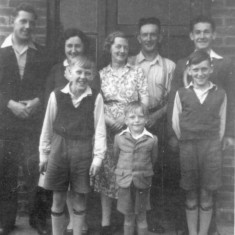

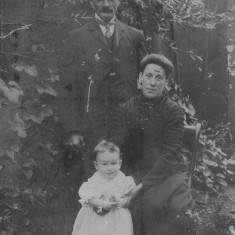
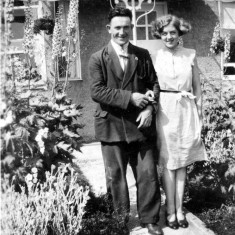
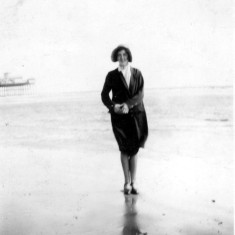
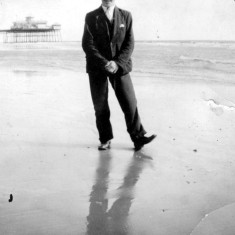
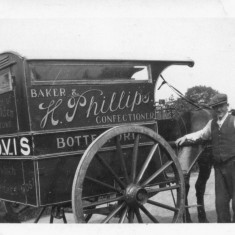
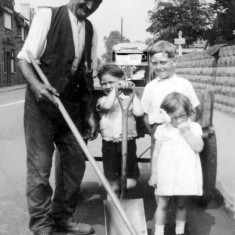
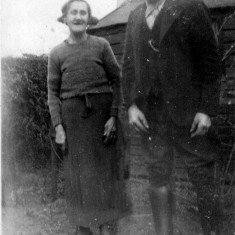
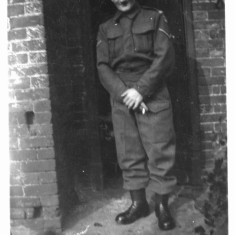
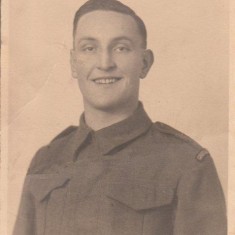
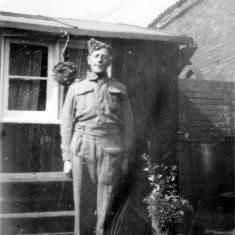
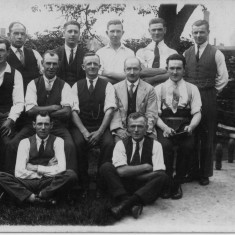
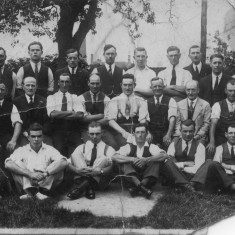
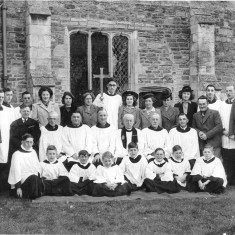
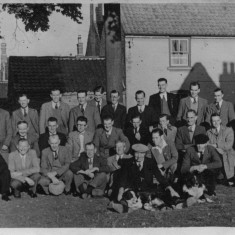
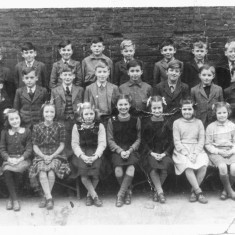
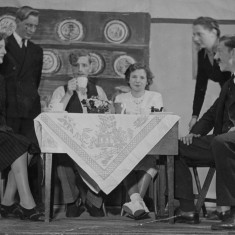
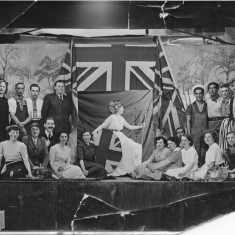
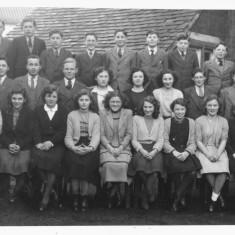
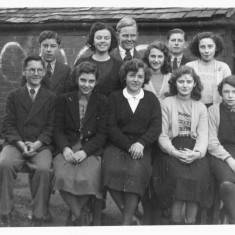
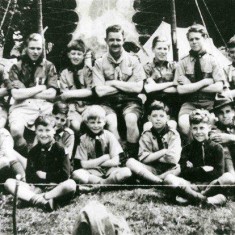
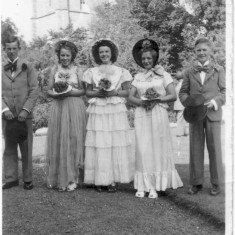
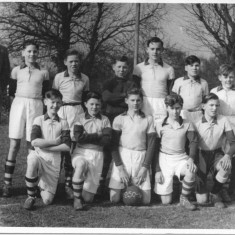
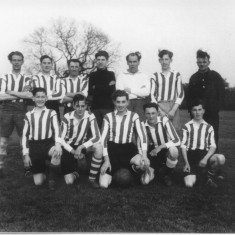
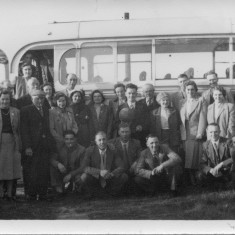
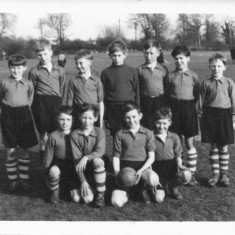
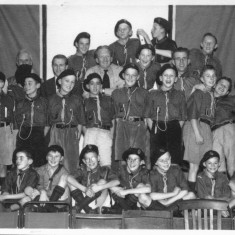
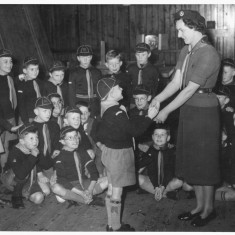
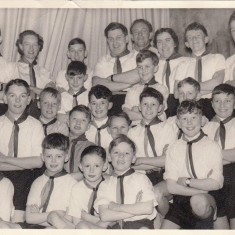
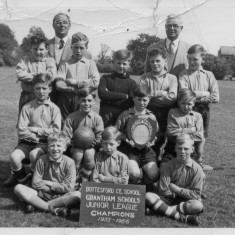
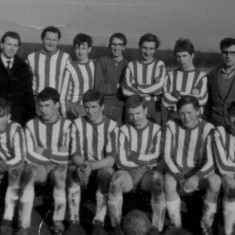
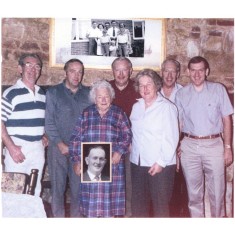
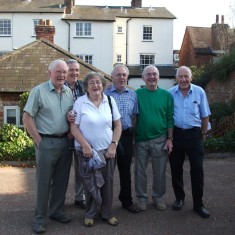








Comments about this page
I can honestly say George & Tony I read your delightful family history with tears in my eyes. What a wonderful descriptive explanation of village life of a never to be repeated era and because it was so similar to ours, the Bradshaw’s. We also look back with a great deal of pride, being part of what was Bottesford, albeit almost my first home but now no longer, but it will always be my real home and always will be. I’m not sure if all the following generations will remember with the same amount of pride that we have for our early beginings in dear old Bottesford. Our regards to you and all of your family and also being our near neigbours in North Crescent, all those years ago. Kindest Regards Mick& Liz Bradshaw Adelaide Australia )
What a wonderful story! Michael & Liz emailed me from Australia to say it was now included in the Bottesford History. I loved reading every minute of it and seeing all the pictures. It brought back wonderful memories for me seeing all those familiar faces even though I couldn’t remember all the names. Perhaps not many people remember me as we left Bottesford when I was 11. We lived on Church Street and my parents were Frank & Ingrid Sellers. Sadly both Mum and Dad have passed away this year, Mum in April aged 94, and Dad in July aged 98. Everything mentioned in your story reminded me of my wonderful childhood in Bottesford. My Uncle Edgar Culpin is included in one of your pictures. Thank you so much for bringing back so many memories. Brenda Turier (Sellers)
Wow! Very interesting page. I recently found out I’m related to Bollands family from Rutland. My great great grandmother was Frances Ann Bollands and her mother was Emma Cunnington and John Bollands. Not sure if this is same connection but intersting all the same. Thank you for sharing your wonderful page. Kind regards, Mandy.
Great to read the family history. George is my brother-in-law and I know family is everything to him. I can see it goes back a long way. Happy childhood memories are worth a fortune. The stories can be told and retold over and over again and still bring more laughter and tears as the years go by.
Hello I found a bible at work with John Edward Bollands 1871…Clara Bollands 1872…I can send a pic of details if you send me email address. Sharon
Hi Sharon .Sure I am interested in your find of the bible and of course the signatures. Tony may know of the past signatures? I would be pleased to recieve your find.Thanks for being observant and thoughtful to us. The Bollands!!
Not knowing your address or E-mail, perhaps the secretary could,with my permission give you my E-Mail address. Thanks for your kind thoughts. Regards George
Thanks, George – I have sent the details, as requested. Neil Fortey, editor.
Thanks Neil. What a wonderful history system you people are running.
I read this page with great enjoyment. From the names and dates I came to the conclusion that George and Tony must be a few years older than me, but a lot of what they have written is very familiar to me. Tommy Samuel also delivered our coal. I also went to school with his daughter Catherine. We also started our Sunday School career at the chapel over the bridge, but we “defected” to church as they had better books when the annual book giving ceremony took place. I know this sounds awful, but I got to love Sunday School and went morning afternoon and also to Evensong.
I remember Mr Stimpson so very well. Not only was he a brilliant teacher, but he was an equally brilliant artist. I remember when the autograph craze got hold of us and instead of giving an autograph, he would do a marvellous pen and ink drawing.
Equally I remember with affection Mr Dewey and Mr Wilson. I remember when I sat the 11-Plus at the end of the summer term. All through the summer holidays we were all eagerly awaiting the results and I went down with chicken pox. Just as I was nearly recovered, George Dewey came cycling up to the house to tell mum that I had passed!!!!!. I think he went round all of us to tell us the good news. I think his dad was not best pleased.
All through school my best friend was Christine Goodson. Her father Henry Goodson owned Nook Farm and one of our main playing areas was the Nook which I believe is now called Pinfold Lane. I think Mr Samuels had his coal yard there. Although there were no Lancs or Spits by now, as the war had been over a few years, I still remember the rounded Nissen huts that were still situated a little further down the lane from the farm.
Dear Carol, thank you for your latest two comments, including the one on this page. We are looking forwards to seeing your pictures. If it helps, we can scan them here, if you were prepared to post the photos to us, and of course we would return them immediately they have been scanned. However, I realize not everyone is happy to do this, and it will be fine if you email scans to us.
In the mean time, I wonder if you have come across the page about the autograph books like the one you describe. This one belongs to Mrs Pauline Gilbert (nee Taylor):
http://www.bottesfordhistory.org.uk/content/catalogue_item/bottesford-local-history-archive/a-bottesford-schoolgirls-autograph-book
With very best wishes, Neil Fortey
Add a comment about this page